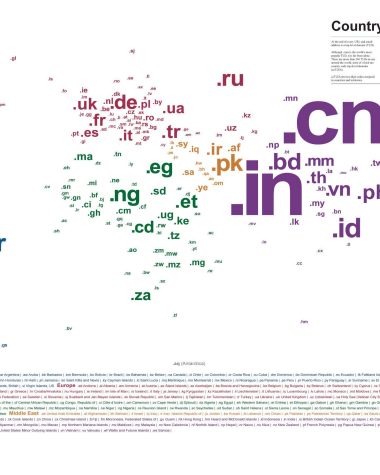In the realm of internet addresses, a top-level domain (TLD) is the segment located to the right of the final dot in a domain name. For instance, in the URL “www.example.com”, “.com” is the TLD. TLDs play an important role in helping categorize, organize, and recognize websites on the internet. Below, we delve into the various types of TLDs and offer examples for each category.
1. Generic Top-Level Domains (gTLDs):
This is the most common category of TLDs. They are further sub-divided based on their use and purpose.
General Purpose:
.com (commercial)
.net (network)
.org (organization)
.info (information)
Restricted Use:
.edu (education institutions)
.gov (U.S. government entities)
.mil (U.S. military)
Sponsored:
.aero (air transport industry)
.museum (museums)
.coop (cooperatives)
.jobs (employment-related sites)
2. Country Code Top-Level Domains (ccTLDs):
These are specific to individual countries and territories. Each country has its own unique two-letter code.
.us (United States)
.uk (United Kingdom)
.ca (Canada)
.au (Australia)
.de (Germany)
.jp (Japan)
.in (India)
.za (South Africa)
.br (Brazil)
.cn (China)
This list is far from exhaustive as every country has its own specific ccTLD.
3. Infrastructure Top-Level Domain:
This category has only one member.
.arpa (originally stood for ARPA Network, and now used exclusively for internet infrastructure operations)
4. Internationalized Country Code Top-Level Domains (IDN ccTLDs):
These are non-Latin character ccTLDs that represent countries and territories in their native scripts.
.中國 (China in Simplified Chinese)
.рф (Russian Federation in Cyrillic)
.السعودية (Saudi Arabia in Arabic)
5. New gTLDs:
In an effort to expand the domain namespace, ICANN (the Internet Corporation for Assigned Names and Numbers) began approving new gTLDs around 2013. These encompass a broad range of topics, industries, and interests.
.app (apps)
.blog (blogs)
.guru (expertise)
.city (cities)
.health (health industry)
.news (news outlets)
.tech (technology)
.club (clubs and organizations)
.store (online retail)
.bike (cycling)
6. Brand TLDs:
Some companies have secured their own branded TLDs to enhance their online brand identity.
.apple (Apple Inc.)
.google (Google LLC)
.amazon (Amazon Technologies, Inc.)
Top-Level Domains have evolved significantly since the internet’s inception, diversifying from a few classic options to a wide array of gTLDs and ccTLDs tailored for specific regions, industries, and interests. Understanding the variety and nuances of TLDs can empower businesses and individuals to select the most appropriate and effective domain name for their online presence.
7. Geographic TLDs:
These are related to specific geographical locations but not limited to country codes.
.nyc (New York City)
.london (London)
.tokyo (Tokyo)
.berlin (Berlin)
.vegas (Las Vegas)
8. Community TLDs:
These are proposed and managed by specific communities that represent a section of the internet population.
.lgbt (for the LGBTQ community)
.catholic (for the Catholic Church)
.kiwi (for New Zealanders, colloquially known as “Kiwis”)
9. Professional TLDs:
Domains associated with specific professions or areas of expertise.
.law (lawyers and legal firms)
.med (medical professionals)
.cpa (certified public accountants)
.engineer (engineering professionals)
- Specialized and Novelty TLDs:
These encompass a wide array of unique interests and niches.
.sucks (typically for criticism and reviews)
.ninja (a novel and unique domain extension)
.beer (for beer enthusiasts and breweries)
.dating (for dating services)
.golf (for the golfing community)
The Importance of Domain Strategy:
For individuals, businesses, and organizations venturing online, choosing the right TLD is a pivotal decision. It can influence how your audience perceives your online brand, affect search engine optimization (SEO) rankings, and play a role in overall brand strategy.
When selecting a TLD, it’s beneficial to consider:
Relevance: Ensure the TLD aligns with your brand, product, or the content of your website.
Memorability: Some TLDs are more memorable than others, which can lead to better brand recall.
SEO: While search engines state that all TLDs are treated equally, a relevant and keyword-rich domain might have better chances in search results.
Availability: With the increasing number of websites, getting your desired “.com” might be challenging. Newer TLDs can offer more availability and unique branding opportunities.
The Future of TLDs:
As the internet continues to grow and evolve, so too will the range and variety of TLDs. The domain landscape will likely become even more diverse, reflecting the multifaceted interests, industries, and cultures of the global online community.
So, the domain name ecosystem, with its multitude of TLDs, offers unparalleled opportunities for personalization and branding on the internet. Whether you’re a multinational corporation, a local business, a personal blogger, or a tech enthusiast, there’s a TLD out there that fits your needs perfectly.








